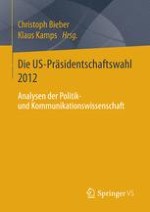2016 | OriginalPaper | Chapter
A Functional Analysis of 2012 United States General Election Presidential and Vice Presidential Debates
Authors : Ph.D. William L. Benoit, Ph.D. Mark Glantz
Published in: Die US-Präsidentschaftswahl 2012
Publisher: Springer Fachmedien Wiesbaden
Activate our intelligent search to find suitable subject content or patents.
Select sections of text to find matching patents with Artificial Intelligence. powered by
Select sections of text to find additional relevant content using AI-assisted search. powered by
